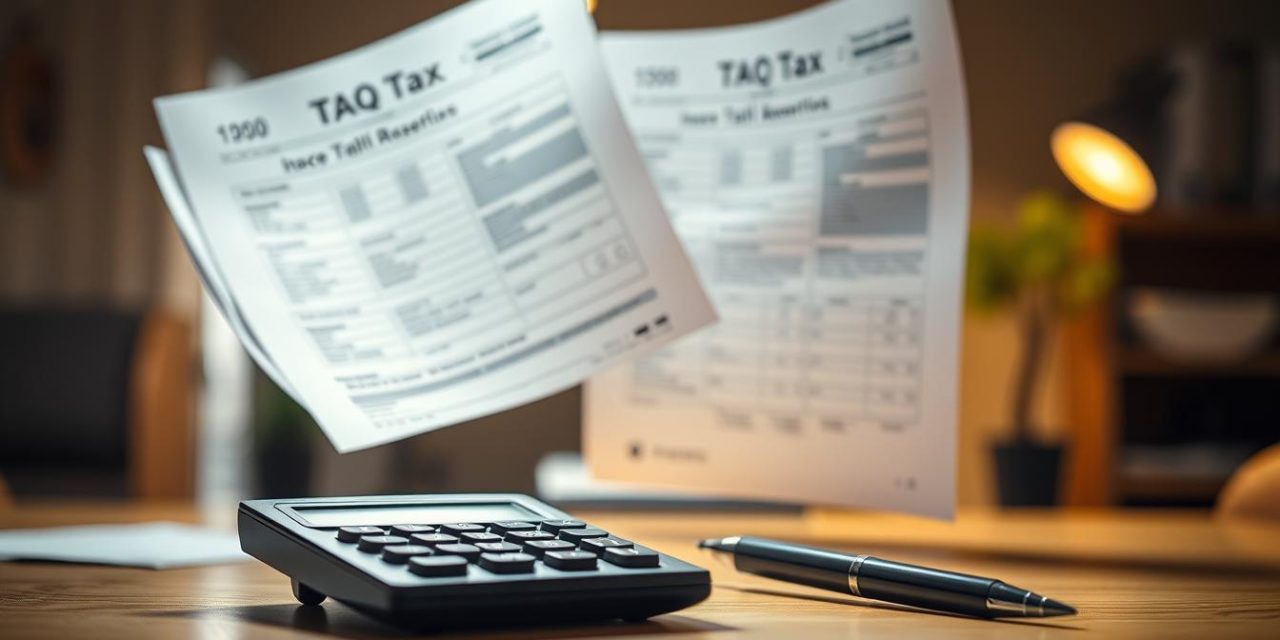When Claire opened her first invoice in Paris, she felt a mix of pride and worry. She knew that running a freelance business meant handling income, rules, and paperwork. She did not know where to start.
We walked her to the official portal and to clear, reliable information. The French site (impots.gouv.fr) explains expatriate and impatriate regimes and how a business is considered established in France. That clarity reduced her stress.
In this short guide, we outline practical steps you can take. You will learn what applies at the business level and what affects your personal income. We focus on essentials and link each rule to its real-world purpose.
Our aim is to help you act with confidence. Expect clear examples, checklists, and pointers to official sources so you can make decisions that protect cash flow and support growth.
Table of Contents
Key Takeaways
- Official French sources like impots.gouv.fr are the best starting point.
- Understand how your freelance activity becomes established in France.
- Know which items reduce business vs. personal income.
- Follow simple steps to protect cash flow and remain compliant.
- Use the guide as a checklist at year end to avoid surprises.
Why this Ultimate Guide to tax benefits matters for freelancers in France
Freelancers need clear, actionable guidance to manage obligations and plan for growth.
We offer practical steps so you may also anticipate cash flow and schedule investments. France provides simplified procedures and strong legal certainty for setting up a business. Official portals give reliable information and an overview of the relevant tax regime.
Knowing key deadlines in the tax year and the year following helps you avoid penalties. We explain the purposes behind common rules and how they interact with your income tax obligations as an independent professional.
« Clear rules reduce stress and let you focus on building your activity rather than chasing paperwork. »
What you will find here:
- Steps to apply rules in the right order.
- Where to read authoritative details and how to interpret them.
- Top-line context for higher education and professional training choices.
| Focus | Why it matters | Action |
|---|---|---|
| Deadlines | Aligns cash flow with compliance | Mark calendar for tax year and year following |
| Regime choice | Determines reporting and deductions | Compare options against projected income |
| Training | Supports professional growth | Document costs and relevance to business |
Who qualifies: being established in France for tax purposes
Start by confirming where your life and work are anchored during the year to know which rules apply. Official French sources such as impots.gouv.fr set the framework used to assess residence and fiscal attachment.
Resident status and being subject income tax
To know if you are subject income tax in France, check your resident status and your center of economic interests. Look at where you live, where most clients are, and where your decisions are made.
When your freelance activity is established in France
Being established in France for tax purposes means your activity is effectively carried out from French territory. Key conditions include where you perform work, bill clients, and manage administration.
| Indicator | What it shows | How to document it |
|---|---|---|
| Residence | Main home or family ties | Lease, utility bills, ID |
| Economic centre | Where income is generated | Invoices, client contracts, bank statements |
| Business control | Where decisions are taken | Meeting minutes, email logs, accounting |
| Period considered | Assessment over the tax year | Consistent records covering the year |
The administration evaluates facts over a defined period, usually the year. If circumstances change mid-year, keep clear evidence to show where your primary ties remain.
Remember: a company must follow different rules than an individual. For cross-border cases, review double tax treaties and seek guidance early to limit disputes about where part of your income is taxed. For practical queries see our note on tax implications.
Choosing your tax regime as a freelancer: micro vs réel
Choosing the right regime shapes how you record income and what you may deduct.
Micro-BNC / auto-entrepreneur: thresholds and simplified return
The micro-BNC tax regime is designed for simplicity. It applies when your turnover stays below defined thresholds and the period application favors streamlined reporting.
Under this form you use standardized abatements rather than tracking every expense. Filing is lighter, but exceeding thresholds or specific conditions can move you to the réel regime.
Régime réel: actual-cost deductions and accounting duties
The régime réel lets you deduct real costs. You must keep invoices, ledgers, and clear support for each item.
This approach suits a business with rising expenses or investment needs. Proper bookkeeping protects figures during review and captures allowable reductions to your taxable base.
Impact on VAT, social levies and your income tax return
Your choice affects VAT handling, social security contributions, and how part of your income appears on the income tax regime form. Align the filing frequency and form with your regime to keep cash flow steady and compliant.
Core tax benefits for freelancers in France

Understanding how deductions, credits, and exclusions interact helps freelancers keep more of their income.
Deductions vs credits vs exclusions
A deduction lowers the amount of income you report as taxable. It reduces your taxable basis before the rate applies.
A tax credit reduces the final amount you owe. When possible, a credit can be more valuable than a deduction of the same amount.
« A credit reduces what you owe; a deduction reduces what is taxed. »
Exclusions remove certain receipts from reporting entirely. You may not then use that same amount again for a deduction or credit.
Common expenses eligible for deduction
- Office rent, professional subscriptions, and business insurance — document the amount and purpose.
- Equipment and software purchases — note the date, supplier invoice, and link to activity.
- Travel and client meeting costs—use a clear ledger showing business reason and amount.
Practical advice: map major costs early, keep tidy accounts, and justify the basis for each claim. Review your choices under the chosen tax regime to avoid double-counting and to set the right amount on your return.
Income tax, social security, and business taxes to take into account
Freelancers must track which parts of their revenue will be declared and when payments fall due.
Your taxable base is the portion of income that remains after allowable deductions under your chosen regime. Knowing what is subject income helps you forecast your income tax and set aside the right reserves.
What portion is taxed each year
Calculate the part of revenue exposed to levy by mapping invoices, deductible costs, and timing. Keep records so you can split receipts across the correct year and form.
URSSAF and how social security contributions interact
URSSAF contributions often represent the largest recurring charge. Plan their amounts alongside income tax to avoid cash strain.
Timing matters: estimates and regular payments affect final balances. Align your contributions schedule with invoicing cycles to smooth cash flow.
Local business taxes (CFE): conditions, dates, and amounts
Local levies such as the CFE depend on business location and activity. Note the due date and expected amount early in the year.
« Budgeting for every levy simplifies compliance and protects your operating cash. »
- Keep personal and business accounts separate to simplify forms and audits.
- Use a calendar that combines filing dates, URSSAF deadlines, and local payments.
- Revisit advance payments if your activity changes to avoid large year-end balances.
| Liability | Who pays | Typical timing | What to track |
|---|---|---|---|
| Income tax | All residents with taxable income | Annual return; monthly/quarterly instalments possible | Taxable base, deductions, declared portion |
| URSSAF contributions | Self-employed and independents | Monthly or quarterly | Declared revenue, rates, payment receipts |
| CFE (local) | Businesses with premises or fixed establishment | Annual; local deadline varies | Location, assessed amount, exemption conditions |
| Advance payments | Applicable to some regimes | Several dates across the year | Projected revenue, adjustment requests, payment form |
For procedural guidance on social charges and applicable conditions, consult our note on exemption procedures. Clear planning reduces surprises and keeps your business stable.
Education and training: understanding credits, deductions, and exclusions

A clear approach to education spending makes it easier to decide whether to claim a credit or a deduction.
Why the distinction matters: an education tax credit lowers what you owe directly. A deduction lowers the income on which the rate applies. Choosing the right path can improve cash flow and the eventual result on your return.
Using education-related concepts to plan professional upskilling
When you plan higher education or short courses, map outcomes to your current services. If a programme maintains or improves skills tied to your work, it may qualify as a business expense.
Practical checks:
- Document course content, provider status, and how it links to your services.
- Keep a dedicated account or sub-ledger for training costs to show what you used pay.
- Assess whether a credit or deduction gives the best result before committing.
Business deduction for work-related education when you are self-employed
If higher education directly supports the skills you use in your activity, treat it as a business deduction against the taxable basis. Maintain invoices and a short note explaining how the course improves delivery or pricing power.
« Keep clear files: the stronger your documentation, the easier it is to justify the claim. »
Finally, avoid double-counting. If an exclusion or a saving vehicle shields an amount from income, you may also not reuse that same amount for a credit or deduction. Plan annually, prioritise courses that match strategic goals, and review results next year to refine your learning budget.
Expatriate and impatriate considerations
If you arrive from abroad or split work across borders, the expatriate regime can change how some earnings are treated.
Overview of the expatriate regime on impots.gouv.fr
France’s official portal summarises rules for newcomers and returning residents. The page explains who may qualify and what documentation supports claims.
Overview of the expatriate regime referenced by impots.gouv.fr
The regime can grant a partial exemption for defined categories of remuneration linked to relocation, expatriation or specific foreign assignments.
Whether you are established France for tax purposes will shape which worldwide or French-source income is taken into account.
Partial exemption scenarios and income taken into account
In some cases a portion of your earnings is relieved if you meet strict conditions about role, duration abroad, or the nature of the contract.
- Partial exemption may apply only to certain allowances, bonuses, or salary elements; not all income qualifies.
- The administration examines facts; clear contracts, arrival dates, and payroll entries help substantiate claims.
- If you remain subject income tax in more than one country, double-taxation treaties can affect the final position.
« Document the facts and dates: timing often decides whether a portion is exempt or fully subject tax. »
Practical step: consult the expatriate overview on impots.gouv.fr early, track arrival and contract changes during the year, and seek advice when conditions are complex.
Compliance timeline and forms: from tax year to the year following
A clear compliance timeline helps you move from bookkeeping to filing with calm and confidence.
Start by mapping the year. Build a calendar that lists each key date for estimated payments, declarations, and the final tax return. Then extend it into the year following so deferred obligations are visible.
Identify the exact period each return or payment covers. This avoids errors when activity spans two calendar years or when you make adjustments.
What to include on your income tax return
Prepare the information you will report in advance. Reconcile your accounts, verify deductions and credits, and gather supporting records before filling any form.
- Establish an order of operations: reconcile, verify, complete forms, and review.
- Keep confirmations and acknowledgments for every return you file.
- If your business changes, update the filing method and forms early.
« Ensure each part of your return tells a consistent story: revenue, costs, and calculations must align with ledgers. »
| Key date | Action | Period covered |
|---|---|---|
| Estimated payment dates | Schedule instalments and set reminders | Ongoing within the year |
| Annual declaration | Complete the income declaration form and attach schedules | Tax year (calendar year) |
| Corrections and amendments | Note the date and period being adjusted; keep clear records | Year following original return |
Worked examples: how amounts flow through your return
These examples map the flow of revenue, contributions, and credits across a tax period to make the mechanics concrete.
Example: micro regime with credits and contributions
Start with a gross amount of €30,000 for the period. Apply the standard abatement (for example 34%), leaving the taxable portion shown on the income tax base.
Social contributions are added conceptually to show total burden. They do not change the income tax base but increase the cash outflow during the year.
Then apply a hypothetical credit of €300. That credit reduces the final sum due after rates are applied, not the taxable amount itself.
Example: réel regime with itemised expenses and credit interaction
Begin with €30,000 revenue and list eligible expenses: €4,000 equipment, €3,000 rent, €1,200 travel. Net business result equals revenue minus expenses.
The net amount forms the basis of the income tax calculation. A credit of €300 lowers the final liability, while a deduction of €300 would reduce the taxable base first.
Timing matters: a late invoice recorded after year-end moves the amount into the next period and changes interim instalments due.
« A credit reduces what you pay at the end; a deduction lowers what is taxed first. »
| Scenario | Starting amount | Key flow | Effect of a €300 credit |
|---|---|---|---|
| Micro regime | €30,000 | Standard abatement → taxable portion → income tax | Reduces final payable by €300 |
| Réal regime | €30,000 less €8,200 expenses | Net business result → taxable base → income tax | Reduces final payable by €300 (after tax calc) |
| Late invoice adjustment | €1,000 moved to next period | Shifts part of revenue to next period; alters instalments | May increase next period instalment or reduce current refund |
Quick checklist before you model:
- Revenue by period and invoices.
- Recurring costs and one-off investments.
- Credits considered and expected contributions.
- Supporting evidence for each deduction or credit.
Optimization checklist for the current year
Begin your optimisation by setting a clear order for record-keeping and deadlines. This short checklist helps you act in sequence and keeps the year manageable.
Ordering your actions: from setting up accounts to documenting expenses
Put your accounts in order first: separate business banking, consistent invoicing, and clear categories for costs.
Define the tax regime you will use this year and confirm any conditions that affect deductions and credits.
- Record revenue, reconcile expenses, and label what was taken account for each item.
- Schedule periodic reviews to estimate income, contributions, and required reserves.
- For training, link the course to your subject income so the rationale for a claim is documented.
Using tax credits and deductions without double-counting
Use tax credit claims thoughtfully. Document invoices, contracts, and proof of payment so each amount is supported.
Do not apply a credit and a deduction to the same expense. Close the loop monthly: check what you used pay matches your account entries.
« Small reconciliations throughout the period prevent big year-end corrections. »
| Step | Action | Why it matters |
|---|---|---|
| 1 | Order accounts | Simplifies filing and audits |
| 2 | Verify regime & conditions | Affects eligible claims |
| 3 | Monthly reconciliation | Keeps amounts aligned with filings |
Conclusion
,Close the guide with a short plan you can use all year.
Define the tax regime and map how your income becomes subject to income tax. Keep a simple account of each amount and why you paid it.
Track timing so each item falls into the correct period and appears on the tax return in good order. Use tax credits deliberately and record them in a schedule to avoid double-counting.
When training or higher education applies, note whether expenses eligible are deductions or interact with a credit. If expatriate rules matter, check income tax exemption possibilities early.
Over five years, steady reconciliations, timely filings, and a living checklist will improve forecasts and calm for every return. For procedural steps on filing, see our guide to the freelance declaration: declaration for freelancers.
FAQ
Who qualifies as established in France for income tax purposes?
You qualify if France is your main place of residence, your principal economic activity is carried out here, or your center of vital interests is in France. For freelancers this typically means living in France more than 183 days a year or having your primary business operations and clients based here.
What is the difference between the micro and réel regimes?
The micro regime applies when your turnover stays below set thresholds and offers a simplified return with a fixed allowance for expenses. The régime réel requires full bookkeeping and lets you deduct actual expenses and social security contributions from taxable income, which can lower your net income subject to tax when costs are significant.
What thresholds determine eligibility for Micro-BNC or auto-entrepreneur status?
Eligibility depends on annual revenue limits specific to services and commercial activities. If you stay below these thresholds, you may opt for the micro regime for simplified reporting. Exceeding them triggers the régime réel with different accounting obligations and VAT rules.
Which expenses are typically eligible for deduction under the réel regime?
Deductible expenses include office rent, professional insurance, equipment, travel and mileage for client work, utilities, and certain education or training costs directly tied to your business activity. Keep invoices and proof of payment to meet documentation requirements.
How do deductions differ from tax credits and exclusions?
Deductions lower your taxable income base, while credits reduce the actual tax owed. Exclusions remove certain income from taxation entirely. Use deductions first to reduce income; credits can then lower your tax bill further. Be careful to avoid double-counting the same cost.
How do social security contributions (URSSAF) interact with income tax?
URSSAF contributions are mandatory and partly deductible under the réel regime. They also determine your social protection entitlements. When filing, you report contributions on your income tax return so they are taken into account in calculating net taxable income or available credits.
What local business taxes should freelancers consider, like CFE?
The Cotisation Foncière des Entreprises (CFE) applies to most self-employed workers and depends on your business location and rental value. Exemptions can apply for new small businesses in the first year. Check deadlines and the taxable base with your local tax office.
Can education and professional training costs be deducted or credited?
Yes — training directly related to your activity can be a deductible business expense under the réel regime. In some cases, specific credits or exemptions may apply for professional development. Keep course descriptions and payment evidence to justify the deduction.
How does the expatriate or impatriate regime affect my taxable income?
Special provisions exist for impatriates and expatriates that can partially exempt certain employment-related income or allow temporary relief. The exact treatment depends on residency status, duration, and the type of income. Refer to impots.gouv.fr and consult a specialist for complex cases.
What are the key dates and forms for filing and payments?
Annual income declarations follow the calendar year, with returns typically filed in the spring of the following year. Payment schedules for income tax and social contributions vary; instalments or monthly direct debits are common. Keep track of municipality deadlines for local contributions like CFE.
What information must I include on my income tax return as a freelancer?
Include total gross receipts, chosen tax regime, deductible expenses or applicable allowances, URSSAF contributions, and any applicable credits or exclusions. Provide supporting documents on request and keep detailed records for the statutory retention period.
How do micro-regime amounts and credits flow through an example return?
Under micro, your gross receipts get an automatic flat deduction and the remainder is taxed under the individual scale. If you qualify for specific credits, they reduce the final tax liability. This regime simplifies accounting but offers less opportunity to deduct actual costs.
How does a réel regime example differ when you have significant expenses?
With réel, you list actual expenses and social contributions, reducing net profit reported. VAT obligations and precise bookkeeping apply. This often results in a lower taxable base when professional costs are high, making it advantageous for capital-intensive activities.
What practical steps should I follow to optimize my situation this year?
Organize invoices and bank statements, choose the appropriate regime before year-end, document training and business purchases, and plan payments to smooth cash flow. Review available credits and exemptions and avoid double claims. Consider professional accounting help for complex cases.





